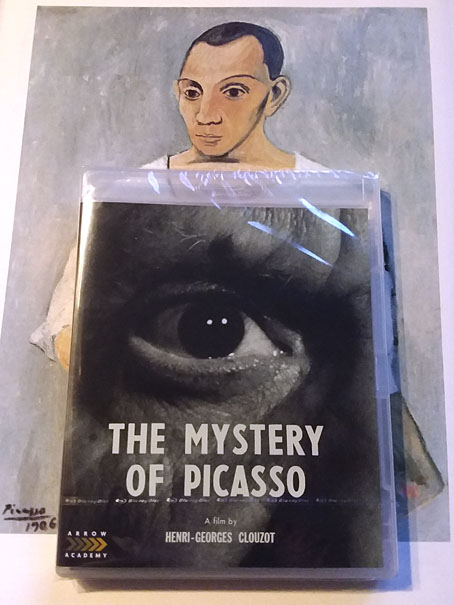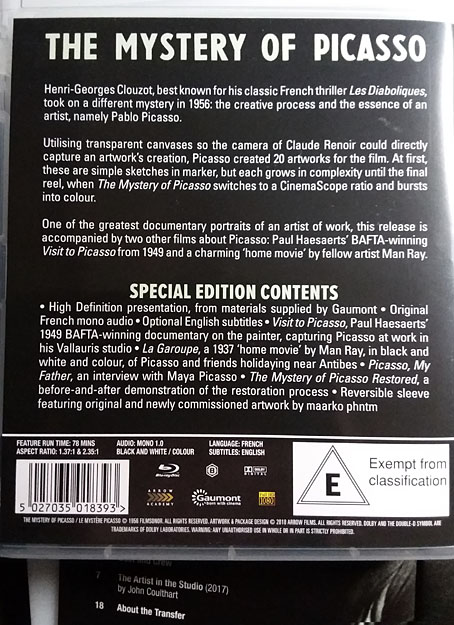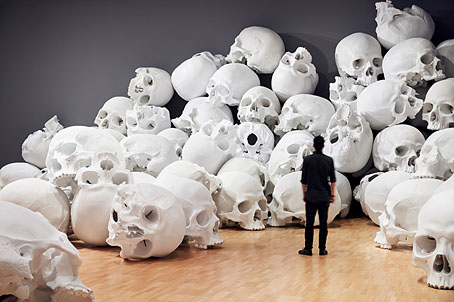This week I’ve been rushing to complete a series of illustrations so there’s been no time to write the post I had in mind. In its place, here’s a preview of another series I was working on in September which I’m told should be published soon. More about that later, and yes, the similarity to Friedrich’s Wanderer above the Sea of Fog was intentional.
Category: {work}
Work
The Mystery of Picasso
I mentioned late last year that I’d written the booklet notes for a forthcoming DVD/blu-ray of The Mystery of Picasso (1956) by Henri-Georges Clouzot, a film receiving its blu-ray premiere this month courtesy of Arrow Academy. The discs are now on sale (UK only, I’m afraid) either online or anywhere that stocks Arrow titles. (Fopp is my preferred outlet.) For those outside the UK, the restored film is also available on iTunes. Clouzot’s film was regarded as an oddity in the 1950s, the director being best known for outstanding thrillers like The Wages of Fear and Les Diaboliques. Today The Mystery of Picasso is regarded as one of the great films about art for the way it successfully captures Picasso in a decade when he was still fervently productive, despite being in his 70s.
Almost all films of this type favour the documentary approach, usually with a camera and interviewer dogging the subject’s footsteps while showing little of the creative process. Picasso wouldn’t have participated in anything like this—he was appalled by a documentary he saw about Matisse—but Clouzot persuaded him that a film could be made showing him drawing and painting in a studio environment. This approach had precedence in Paul Haessarts’ short film from 1949 (included among the disc extras) which showed Picasso in his studio at Vallauris; the film ends with a series of paintings on glass of various animals and human figures. Clouzot expanded on Haessarts’ idea with the full range of film technology: time-lapse, black-and-white stock, colour stock and Cinemascope. The works Picasso creates for the camera aren’t his best—how could they be when they were being produced at speed in sweltering, time-constrained conditions? But the film is a miraculous portrait of an artist whose name is still universally recognised almost fifty years after his death. By chance or design, it’s also a partial portrait of Clouzot himself who appears in several of the shots to discuss new camera setups.
There’s no need for me to say more about the film when I discuss it at length in the booklet. For a review of the disc contents, there’s a substantial appraisal here. For more about Henri-Georges Clouzot I recommend the study by Christopher Lloyd which was invaluable for its details about the film’s production.
Previously on { feuilleton }
• Picasso-esque
• My pastiches
• Cubist Cthulhu
The Demons of King Solomon
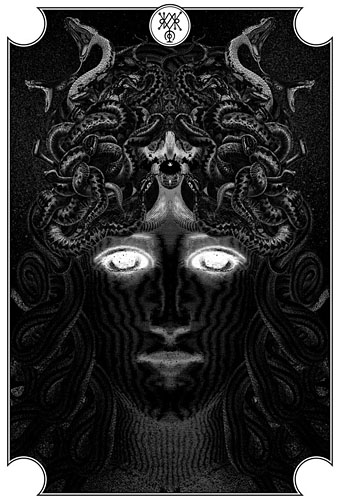
Abyzou.
Presenting my illustrations for The Demons of King Solomon, a horror anthology edited by Aaron French. This is a follow up to Aaron’s The Gods of HP Lovecraft which was published by JournalStone in 2015. I did 6 illustrations for the Lovecraft volume, covering half the stories whereas the new book has illustrations of mine for every story.
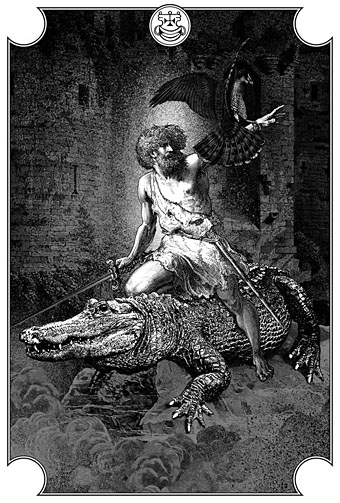
Agaras.
The brief for the authors this time was to write a story incorporating a Solomonic demon of their choosing. There are many of these, from the ones described in the Testament of Solomon to the 72 listed in the Ars Goetia (or Lesser Key of Solomon), the latter being familiar to many people via their often comical depictions in De Plancy’s Dictionnaire Infernal. My original intention for the illustrations was to do a series of pictures based on each story. Some of the stories were late in arriving, however, and I only had a month free for the work so I changed the plan to a series of depictions of the demons as they’re described in the grimoires. This makes more sense when many of the stories have the demons masquerading in human guise, so the illustrations not only show something new but also act as a connection back to their infernal history. Agaras (or Agares), for example, is described by the grimoires as an old man riding a crocodile with a hawk on his arm. Most of the seals on each picture are taken from the ones for the demons shown in the Ars Goetia. Not all the demons in the anthology are listed there so I had to invent a few seals to fill out the collection. I’ll let people guess which are genuine and which are inventions. The Demons of King Solomon is out now from JournalStone. Larger copies of the illustrations may be seen here.
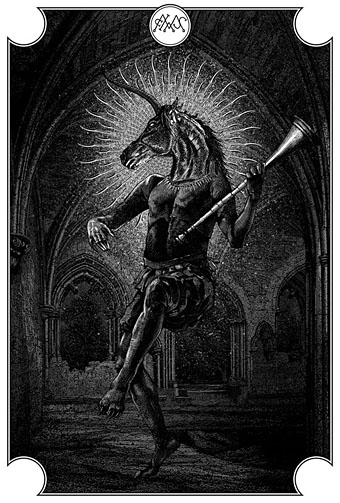
Amdusias.
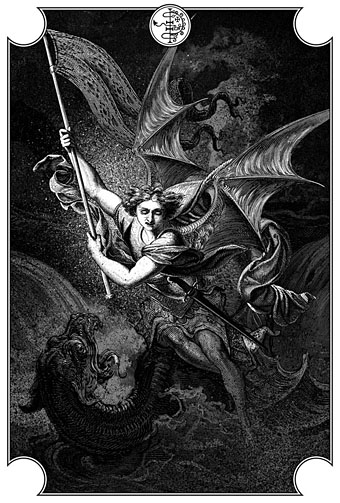
Asmodeus.
Weekend links 392

Art by Twins of Evil for the forthcoming blu-ray from Arrow Academy.
• Images (1972), the film that Robert Altman made between McCabe and Mrs Miller and The Long Goodbye, is the closest the director came to outright horror. A disturbing portrait of mental breakdown, with Susannah York in the lead role, and photography by Vilmos Zsigmond, the film has for years been so difficult to see as to be almost invisible. Arrow Academy will remedy this situation in March next year with a new blu-ray restoration. Related: Geoff Andrew on where to begin with Robert Altman.
• “[Johnson] is a paltry, utterly conventional, upwardly mobile, morally squalid parvenu who yearns to be taken for what he isn’t.” Jonathan Meades‘ vitriol is in a class of its own, here being deployed in a review of Nincompoopolis: The Follies of Boris Johnson by Douglas Murphy.
• “These films, all preserved in the BFI National Archive, are known as Orphan Works. When the rights-holder for a film cannot be found, that film is classified as an Orphan Work.” 170 orphaned films have been added to the BFI’s YouTube channel.
Don’t romanticize science fiction. One of the questions I have been asked so many times I’ve forgotten what my stock answer to it is, ‘Since science fiction is a marginal form of writing, do you think it makes it easier to deal with marginal people?’ Which—no! Why should it be any easier? Dealing with the marginal is always a matter of dealing with the marginal. If anything, science fiction as a marginal genre is more rigid, far more rigid than literature. There are more examples of gay writing in literature than there are in science fiction.
Samuel Delany in a lengthy two-part interview with Adam Fitzgerald
• One of the books I was illustrating this year was The Demons of King Solomon, a horror anthology edited by Aaron French. The collection is out now; I’ll post the illustrations here in the next month or so.
• Mixes of the week: Routledge Dexter Satellite Systems by Moon Wiring Club, No Way Through The Woods: A Conjurer’s Hexmas by SeraphicManta, and FACT mix 632 by Priests.
• Also at the BFI: Adam Scovell on a film adaptation of MR James that predates Jonathan Miller’s Whistle and I’ll Come To You (1968) by 12 years.
• At Weird Fiction Review: Jon Padgett on absurd degenerations and totalitarian decrepitude in The Town Manager by Thomas Ligotti.
• At Larkfall: Electricity & Imagination: Karl von Eckartshausen and Romantic Synaesthesia.
• It’s the end of December so the London Review of Books has Alan Bennett’s diary for the past year.
• Aquarium Drunkard‘s review of the year’s best music.
• At Dennis Cooper’s: Lotte Reiniger Day.
• Robin Rimbaud is In Wild Air.
• Dream Sequence (Images II) (1976) by George Crumb | Images (1977) by Sun Ra | Mirror Images (1978) by Van Der Graaf
Weekend links 391
Mass by Ron Mueck at the National Gallery of Victoria Triennial. Photo by Tom Ross.
• Thanks of the week: to In Wild Air for asking me to fill their list of six favourite things; to Hodderscape for including my cover for Jeannette Ng’s Under the Pendulum Sun among their choice of best book covers of the year; and to Dennis Cooper for listing this blog among his own end-of-year favourites. Ta, all!
• New/old music: The Quietus reissues, etc, of the year, new Pye Corner Audio, Soul Jazz presents Deutsche Elektronische Musik 3, and The Cleansing is a new album by Annabel (lee).
• Mixes of the week: Seeing The Forest For The Trees by Gregg Hermetech, FACT mix 631 by Zola Jesus, and Secret Thirteen Mix 240 by Restive Plaggona.
Were a normally sexed person to enter such an establishment, he might be puzzled to see so many finely dressed men sitting there with soldiers, though he would find nothing particularly offensive. The friendships between homosexuals and soldiers forged here over sausage, salad and beer frequently endure for the full term of service, and often longer. The soldier returns home, living as a married farmer far from his beloved Berlin garrison, but many a uranian still receives freshly killed quarry as a token of friendship. Sometimes these relationships are even passed on to younger brothers; I know one case where a homosexual had relations with three brothers one after the other, all of whom were with the Cuirassiers.
An extract from Berlin’s Third Sex by Magnus Hirschfeld, one of the new titles from Rixdorf Editions. Ostensibly straight soldiers supplementing their income by having sex with “uranians” was still a common thing decades later, as detailed in John Lehmann’s In The Purely Pagan Sense.
• The Cremator (1968) a film by Juraz Herz, was reviewed on these pages a while ago. It’s now out on region-free blu-ray. Highly recommended.
• At Wormwoodiana: Mark Valentine on a map of old Dunwich, and Egypt in England.
• Clive Hicks Jenkins on Mapping the Tale: image making and the narrative tradition.
• Wyrd Daze returns with a free pdf, and a mix by The Ephemeral Man to download.
• At the BFI: Chris Gallant on where to begin with giallo cinema.
• The Parisian Cabinet of Curiosities Loved by Wes Anderson.
• Mass Production (1977) by Iggy Pop | Mass (1981) by Yellow Magic Orchestra | Mass Transit Railway (1997) by Monolake


